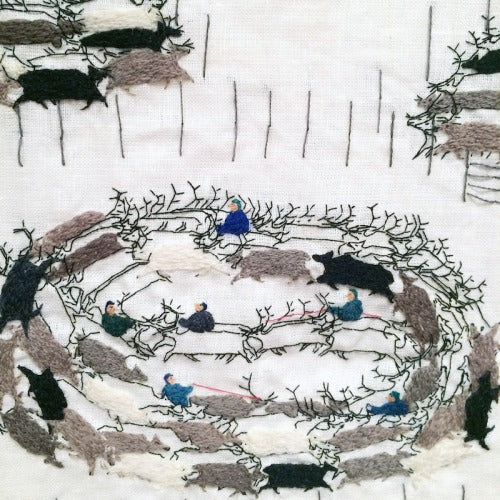Embroidered History - The Story of the Sami...

AN ARTICLE FROM SELVEDGE - The Luna Issue
Previously known simply as ‘Lapland’, a twinkling white snowscape filled with reindeers and forests as far as the eye can see; but the local name for this territory is Sápmi, and its rich and tumultuous history lives on in a poetic new embroidery Historja, made by Swedish textile artist Britta Marakatt-Labba.

In exquisite detail, this artwork reaches back centuries and across 24 metres of linen, mapping out the lives of the land’s indigenous Sami people – of whom MarakattLabba is a descendant. Historja gently leads the viewer into this extraordinary culture. From the everyday tasks of Arctic life to the mythologies and beliefs ingrained into its society, Marakatt-Labba worked on the piece over the course of four years.

The epic embroidery can be read as the artist explains. ‘From the right, the picture opens with a scene in the forest where several faces peep out from between birch trunks.’ To her, these mysterious figures represent ancestors, the ‘mothers of origin’ as she says herself, who share their wisdom with children as they bring their culture into a new era. The close relationship between man and nature is cherished among the Sami, who work with the harsh environment and not against it. Tradition tells us that the Sami people often used wood from nearby forests to make their skis, and the power of local reindeer to help them cross the icy planes. In her embroidery, you can see the Sápmi landscape, sprinkled with a population dressed in traditional warm hats and blankets as they tackle the frost.
In one scene, the artist pinpoints a famous moment in history when the Sami people revolted against Norwegianisation a form of colonisation in the mid 19th century, and known as The Kautokeino Uprising. A group of Sami attacked a local merchant’s building that was representative of Norwegian authorities. They burnt down the store and a church, killing two people. ‘I chose to picture the burning of the church,’ explains Marakatt-Labba, ‘because the priests played a role in instigating the uprising.’ ‘In the middle of the piece you can see three goddesses begging in the hopes that their future generations will be able to live a peaceful life on the land.’

Although the environment is extreme and maintaining a sense of normality can be tough in such treacherous weather conditions, the Sami people generally live peaceful lives and spend a lot of their time fishing, farming, caring for their families and their herds of reindeer. Art forms an integral part of their culture and, unsurprisingly, Marakatt-Labba is at the centre. Part of the Masi Artists Group, formed in 1978, Marakatt-Labba has helped to support a network of makers in the polar regions of Norway, Sweden, Finland and Russia since its inception. She has cemented herself as one of her generation’s most formidable artists and story-tellers. Thanks to her incredible stitched landscapes, the history of the elusive and often misunderstood Sami culture can go on to enter new eras with resounding recall.

With thanks to Beatrijs Sterk, Britta Marakatt-Labba, Sofia Brenner and Elisabeth Brenner Remberg and Ola Petter Røe.
Read all about this extraordinary work in the Luna issue of Selvedge - available here.


